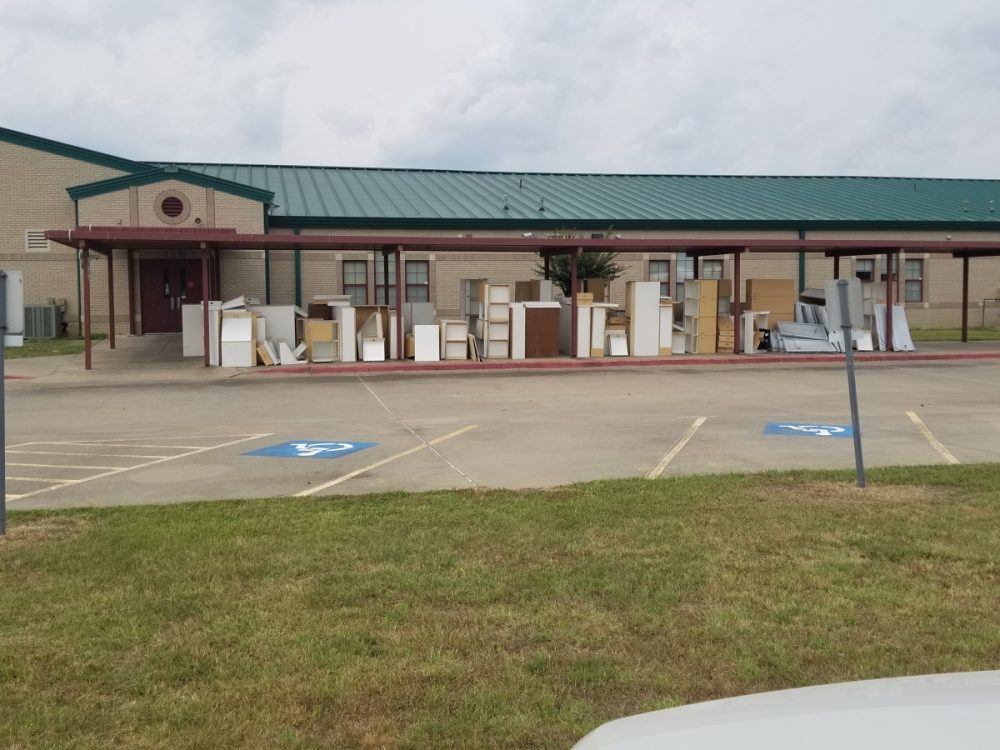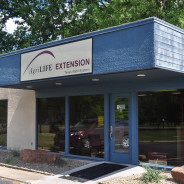Flood Advisory Until 8 p.m. Thursday for Southwestern Hopkins County and Rains County
A flood advisory for Southeastern Hunt, Southwestern Hopkins, and Rains County has been issued by the National Weather Service. Thunderstorms producing heavy rain and excessive runoff will cause small stream flooding. Low lying areas with poor drainage are most likely to experience flooding. Some low water crossings in the area may become impassable.
The advisory for flooding is in effect until 8 p.m.

Significant Weather Advisory: Strong Wind Possible, Heavy Rain in Western Hopkins County
A significant weather advisory issued by the National Weather Service until 6:15 p.m. Thursday for Western Hopkins County. A strong thunderstorm is being tracked by Doppler Radar between Cumby and Sulphur Springs, moving south at 15 mph. Wind gusts up to 50 mph will be possible in this storm.
Heavy rainfall is also occurring with this storm and may lead to localized flooding.

AgriLife: What is Wrong With My Tomato Plant?
by Mario Villarino
If the leaves on your vegetable plants are twisted or curled, the problem could be environmental, chemical, or biological. Sometimes all the leaves on a plant are twisted or curled; sometimes only new growth has symptoms while older leaves are normal. Damage may start moderately then quickly begin to affect new growth. Damage to tomato and other vegetable plants may have one or a combination of causes (Figs. 1-5).
There are five primary reasons that tomato leaves twist or curl:
- Wind damage
- Herbicide drift
- Herbicide residue
- Broad mite
- Tomato viruses
- Wind damage
High winds, blowing dust and low humidity can damage the leaves and stems on tomato plants. Heat and low moisture can cause the edges of the tomato leaves to die back, then twist and curl. Hot dry weather may also cause a symptom called physiological leaf roll. This is a self-defense response, where leaves and leaflets curl slightly to prevent further water loss. Mild leaf roll generally does not lower yields or quality, though severe symptoms may cause flowers to drop and fewer fruit to set.These symptoms may look like damage from other causes, but if wind damage is the only problem, plant health will generally normalize once weather conditions improve.
Herbicide drift: Crops and pastures are often treated with herbicides to prevent or eliminate weeds, and drifting spray can damage tomato plants. Up to 84 percent of the cotton acreage in Texas is sprayed with broad-spectrum herbicides. They are also used on cereal and grain crops. The problem is that wind speeds as low as 5 mph can move these herbicides up to a mile. Many home gardens are close enough to cotton and corn fields for drifting 2,4-D, dicamba, or other hormone-type herbicides to cause serious damage. Tomato plants are extremely sensitive to these herbicides: they can be injured by concentrations as low as 0.1 ppm. If only a little of the herbicide reaches the tomato plants, they can recover, but yield will definitely suffer. In addition to commercial applications, herbicides from home gardeners or their neighbors can drift onto sensitive tomatoes or other vegetables. Weed killers for lawns and landscapes often contain broad-spectrum herbicides such as glyphosate and the growth-regulators such as 2,4-D and dicamba. Examples are Ortho Weed-B-Gon and Fertilome Weed FreeZone. Tomatoes are very sensitive to these herbicides even when applied at extremely low rates. Though the plants may look healthy, drift from these products can reduce the number and the quality of the fruit. There is no remedy for leaves that are already injured by 2,4-D. If new growth continues to show injury symptoms, harvest any salvageable fruits and pull up the plants.If new shoot growth is normal, and there is still at least 4 to 6 weeks left in the growing season, the plants may be able to outgrow the injury. New buds and leaves should begin growing within about a week. If not, pull the affected plants and replant.
To minimize herbicide drift following these steps:
- always read and follow the herbicide label instructions
- avoid spraying when wind speed is more than 5 mph
- avoid spraying when wind is blowing toward sensitive crops
- use a hooded sprayer when applying post-emergence herbicides near growing plants
- reduce spray pressure so droplet size is larger and less likely to move with the winds
- reduce the speed of the spray application to avoid movement in the circulating air
- ensure that the dosage applied is correct
- use the correct spray nozzles/tips for the chemical to be applied
- use drift reducing spray additives if available
- wash out all previous herbicide from inside the spray tank
Herbicide residue: Vegetables can be damaged by herbicides left in mulch or compost made with hay or manure from fields that have been sprayed with Grazon, GrazonNext, or GrazonNext HL. The active ingredient in these products is aminopyralid which persists for 18 months on treated hay and hay products. It also persists in the manure of animals that eat Grazon-treated hay. Grazon products are commonly used in pastures because they kill about 100 difficult broadleaf weeds . The GrazonNext label states that any plant matter collected from fields sprayed with aminopyralid may not be used in compost or where vegetables are to be grown (Fig. 8). The label also states that the “applicator must provide the land manager with a copy of instructions regarding uses of forage from areas treated with aminopyralid.” Anyone who sells hay, silage, haylage, green chop, or bedding material that was treated with aminopyralid, is responsible for alerting the buyer that it was treated and must not to be used in composting or were vegetables are grown. Buyers must also ask whether aminopyralid was used on the source forage within the last 18 months. Additional restrictions in hay and manure use:
- Do not use aminopyralid-treated plant residues, including hay or straw from areas treated within the preceding 18 months, in compost, mulch or mushroom spawn.
- In compost, mulch, or mushroom spawn, do not use manure from animals that have eaten forage or hay from treated areas within the previous 3 days.
- Do not plant broadleaf crops (including soybeans, sunflower, tobacco, vegetables, field beans, peanuts, and potatoes) in fields treated in the previous year with manure from animals that have grazed forage or eaten hay harvested from aminopyralid-treated areas until an adequately sensitive field bioassay is conducted to determine that the amount of aminopyralid residues in the soil will not injure the crop to be planted.
- To promote herbicide decomposition, burn the plant residues or evenly incorporate them in the soil. Aminopyralid breaks down faster in the plant residues and manure when the soil is warm and moist. Irrigation can speed up the process.
- Broad mite damage: Broad mites (Polyphagotarsonemus latus) affect many plant families, including tomato, pepper, eggplant, potato, cotton, and citrus. It also attacks ornamentals such as dahlia, zinnia, chrysanthemum, pittosporum, and schefflera that are grown under shade cloth.
- Broad mites avoid light and feed on young leaves and flowers. As they feed, they inject toxins that severely twist and distort the leavers. The damage may resemble other types of damage on tomato plants. In Texas, broad mites damage seedlings grown in greenhouses or under shade cloth. Severe broad mite infestations can make the underside of leaves and fruit look bronzed or russetted. These mites are invisible to the human eye and can be overlooked even under a magnifying glass. They are usually discovered only after plant injury is noticeable. Broad mites are 0.10 to 0.30 millimeters long, have oval bodies, and can be translucent to pale brown or yellow. If you cannot see the broad mites readily, look for the eggs, which are white, oval-shaped and have ridges or bumps. This mite’s eggs are distinct—they look like Christmas ornaments. Eggs develop into adults in about 4 to 6 days in hot weather and 7 to 10 days in cool weather.
Broad mite populations come and go rapidly depending on food, weather, and light. Infestations are often sporadic and fluctuate from year to year. Broad mites may infest your tomato plants via transplants from greenhouses or the legs and antennae of whiteflies.
Before treating the plants, make sure that broad mites are the problem. If broad mite damage is severe, pull up the plants and dispose of them.
Moderately affected plants can be treated with sulfur-based miticides. However, be sure that the tomato cultivar is tolerant of sulfur before applying it. Do not treat tomatoes when temperatures are higher than 90o F or when the plants are water stressed—the miticide can damage the plant under these conditions. The plants will likely need additional applications to avoid further damage. Other products known to control mites in general include Horticultural Oils and Insecticidal Soaps. You can alternate these treatments with predatory mites that attack and consume broad mites. Predatory mites are most effective if used before the broad mites get firmly established. Predatory mites are sold by many companies specializing in organic products (Grow Organic, Arbico Organic, Benemites are a few examples)
Tomato viruses: Hundreds of viruses can cause leaf curling and stunting in tomatoes. Though initial virus symptoms can be confused with a phenoxy-based herbicide damage, the disease often progresses to include yellow-green mosaic patterns on the leaves. Viruses in the geminivirus group are most often the culprit for virus-based leaf twisting in tomatoes. In Texas, the most common virus encountered is the tomato yellow leaf curl virus. Geminiviruses spread to tomatoes and other plants exclusively by the sweet potato or silverleaf whitefly (Bemisia tabaci). To reduce the spread of this virus, manage whitefly populations with insecticidal oils and soaps. New tomato varieties have been developed that resist tomato yellow leaf curl. However, these varieties are still susceptible to other virus diseases. As with any tomato leaf damage, you must identify the cause before making any management decisions.
For more information on this or any other agricultural topic please contact the Hopkins County Extension Office at 903-885-3443 or email me at [email protected].

SSISD Preparation Underway for 2018-2019 School Year
 Summer months for school maintenance staff and teachers are always filled with preparing for the coming school year. This year an added work load begins as Head Start 3 & 4 and Pre-Kindergarten are moved to the Douglas ECLC campus and Barbara Bush Primary School becomes a Primary campus. Bush Primary will house Kindergarten, all Transitional 1st grade students and a traditional 1st grade. Grade levels 2nd and 3rd grade will be added eventually. All other Primary Schools, Bowie, Lamar, Travis, will be Kindergarten through 3rd grade but will not have Transitional 1st grade classes. The campus and grades served include:
Summer months for school maintenance staff and teachers are always filled with preparing for the coming school year. This year an added work load begins as Head Start 3 & 4 and Pre-Kindergarten are moved to the Douglas ECLC campus and Barbara Bush Primary School becomes a Primary campus. Bush Primary will house Kindergarten, all Transitional 1st grade students and a traditional 1st grade. Grade levels 2nd and 3rd grade will be added eventually. All other Primary Schools, Bowie, Lamar, Travis, will be Kindergarten through 3rd grade but will not have Transitional 1st grade classes. The campus and grades served include:
Douglas ECLC – Head Start 3 & 4, Pre-Kindergarten
Barbara Bush Primary – Kindergarten, Transitional 1st grade, and 1st grade (Will eventually have K-3, plus Transitional 1st)
Bowie Primary – Kindergarten through 3rd grade (No Transitional 1st)
Lamar Primary – Kindergarten through 3rd grade (No Transitional 1st)
Travis Primary – Kindergarten through 3rd grade (No Transitional 1st)
Sulphur Springs Elementary – 4th & 5th grades
Middle School – 6th – 8th grades
High School – 9th – 12th grades
SSHS Athletic Booster Club Memberships Available
Wildcat Booster Club is preparing for the 2018-2019 athletic year and invites Wildcat fans to join. The booster club supports the needs of various athletic programs in Sulphur Springs High School. According to David McCaig, President, 100% of the Wildcat Athletic Booster club donations are used for students and their activities. McCaig stated that the recent sports banquet proves the excellent reputation of student-athletes in Sulphur Springs.
Various membership levels are available and must be received before July 10th to be included in the 2018 Football Program. Booster levels include:
State Champ Wildcat (reserved parking at football games) $200.00 and above
Regional Final Wildcat $150 -199.00
District Champ Wildcat $100-149.00
All-District Wildcat $50.-99.00
Code Blue Wildcat $25-49.00
Team Wildcat $10.00
Membership dues for the Booster Club are $10 for the year and anything given over that amount is considered a donation. Total amount given will be used for the above classifications of support.
To join, mail your membership dues to Wildcat Athletic Booster Club, PO Box 1594, Sulphur Springs, TX. 75483.

FM 2642 at I-30 in Royce City to Temporarily Close for Construction in July
The FM2642 overpass on I-30 in Royce City, Hunt County, will be temporarily closed for construction beginning July 5, weather permitting. Detours will be in place to provide alternate routes.
TxDot requests that motorists please drive safely & friendly, and respect work zones.

Video Presentation: Make-a-Wish Presents a Trip to Disney Land and a Day at the Beach to Sulphur Springs Child with Rare Bone Disease
Make-a-Wish Foundation presented a trip to Disney Land and a day at the beach to Jakaden and his mother Cassandra Yarbrough. Eight (8) year old Jakaden was greeted by family, friends, and representatives of Make-a-Wish Wednesday afternoon at Pizza Hut in Sulphur Springs. The wish grantors surprised Jakaden with the trip that begins Monday. He will return June 16th. Jakaden has a rare bone disease.
Anyone can make a request for a child but usually it is the child’s doctor or the case worker that assists the child and family during the time of their life threatening disease. There are qualifications: 1) the child must be between the ages of 2 and a half years and 18-years of age; 2) must have a life treatening illness; and 3) have not been granted a wish by any other organization.
Jakaden has a sibling, Jakelian. His grandparents are Bobby and Rose Yarbrough. Jakaden gave a thumbs up to the surprise.

Look Up This Weekend for Hot Air Balloons As Part of Dairy Festival!

David Black, Dairy Festival Balloon Committee Chairman and 15-year ballooning enthusiast
David Black jumped aboard the Dairy Festival Board about the same year that hot air ballooning became a permanent feature of the Festival. Since that time, he has flown or crewed for dozens of balloon pilots from all over the United States. During the early years, David even traveled to popular balloon festivals around the country to find out what made them fun, safe and attractive to pilots. Today, the Invitational balloon event during the Hopkins County Dairy Festival incorporates the best practices and ideas, while preserving a down-home dairy country personality. Two of the highlights for balloon pilots who travel here is participating in the cow-milking contest and riding in the Dairy Festival Parade!
This year, there are 32 hot air balloons expected to participate. The FAA-certified pilots will have three opportunities to fly and two major “tether and glow” events for the public. Of course, all balloon flights are subject to weather, and scheduled flights are always “weather permitting”. And as at most balloon events, the designated “Balloon Meister” consults with his Safety Officer and a DFW weatherman at dawn to help him make pre-flight weather decisions about the morning’s scheduled flights. The Hopkins County balloon event is known for it’s attention to safety. “There are two yearly balloon events I wouldn’t miss: Albequerque and Sulphur Springs” is a compliment David has heard more than once from pilots.

Most of the balloon events will take place June 8-10, 2018 in the field behind Shannon Oaks Church, located along I-30 on East Shannon Road in Sulphur Springs. The “tether and glow” on Saturday evening June 9 will also include the State Championship Homemade Ice Cream Freeze-Off at 5:30 pm and live music. All the balloons will be participating in the glow, including two huge “shape” balloons depicting a lady bug and a Spiderman pig. The “competition” part of the Invitational event will take place early Saturday morning as a “Hare and Hound Chase”. Pilots in the air will attempt to hit a target on the ground by dropping a weighted bag, then fly on to the next target on the course.
There is a need this year for additional local crew members. If you would like to volunteer as a ground crew member for balloon flights this weekend, contact David Black at 903-439-4384.
Brownies Found by Hopkins County Deputy in Vehicle Trunk Leads to Arrest of California Woman
A 66-year old California woman and her boyfriend were not consistent in their story told a Hopkins County Deputy, who stopped them for speeding at the 130-mile marker on I-30 Wednesday afternoon. Their brownies found in a tub in the trunk of the vehicle may have been part of the cause for their nervousness and inconsistencies detected by the deputy.

Robin Lynn Hotmer
The pair were traveling from California to Ohio according to their story. They denied consent to search their vehicle but a K-9 deployed in an open air sniff alerted on the vehicle. In the trunk was a large clear tub. In the tub were brownies believed to contain THC. After being read her Miranda rights, Robin Lynn Hotmer, 66, of Placentia, California, said the brownies contained marijuana within the brownies. Marijuana was also found in the vehicle.
Hotmer is in Hopkins County Jail charged with Possession of a Controlled Substance Penalty Group 2 more than 400-grams.

















